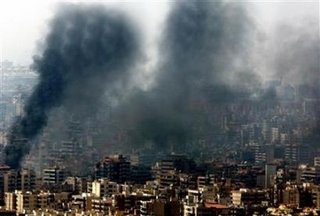On Saturday, August 5th, the news agency Reuters released a photo of a bombing in Beirut which, to anyone with a critical eye, had clearly been altered.

Bloggers across the web quickly commented on the repeating patterns in the smoke and the repeating building under the lefthand column of smoke.
Much of the discussion focused on the crudeness of the alterations. The surprise was not that the photo had been altered, but that it had been done so badly and that no one at Reuters, which is a reputable news service, had caught it.
However, once Reuters realized what had happened, it pulled the photo and replaced it with the original image.
Ynet News, an Israeli English language web site, has an article entitled "Reuters admits altering Beirut photo" which offers a good overview of the story. (It is worth noting that the title of the article is somewhat misleading. Reuters admitted that the photo had been altered and that they had suspended the photographer pending an investigation into the changes which were made.)

Bloggers across the web quickly commented on the repeating patterns in the smoke and the repeating building under the lefthand column of smoke.
However, once Reuters realized what had happened, it pulled the photo and replaced it with the original image.
Ynet News, an Israeli English language web site, has an article entitled "Reuters admits altering Beirut photo" which offers a good overview of the story. (It is worth noting that the title of the article is somewhat misleading. Reuters admitted that the photo had been altered and that they had suspended the photographer pending an investigation into the changes which were made.)






 ms.dsk is reading
ms.dsk is reading  Rob Koelling is reading
Rob Koelling is reading  S. Renee Dechert is reading
S. Renee Dechert is reading  Mary Ellen Ibarra-Robinson is reading
Mary Ellen Ibarra-Robinson is reading  Bill Hoagland is reading
Bill Hoagland is reading  Jennifer Sheridan is reading
Jennifer Sheridan is reading  Robyn Glasscock is reading poetry by
Robyn Glasscock is reading poetry by  Susan Watkins is reading
Susan Watkins is reading
No comments:
Post a Comment